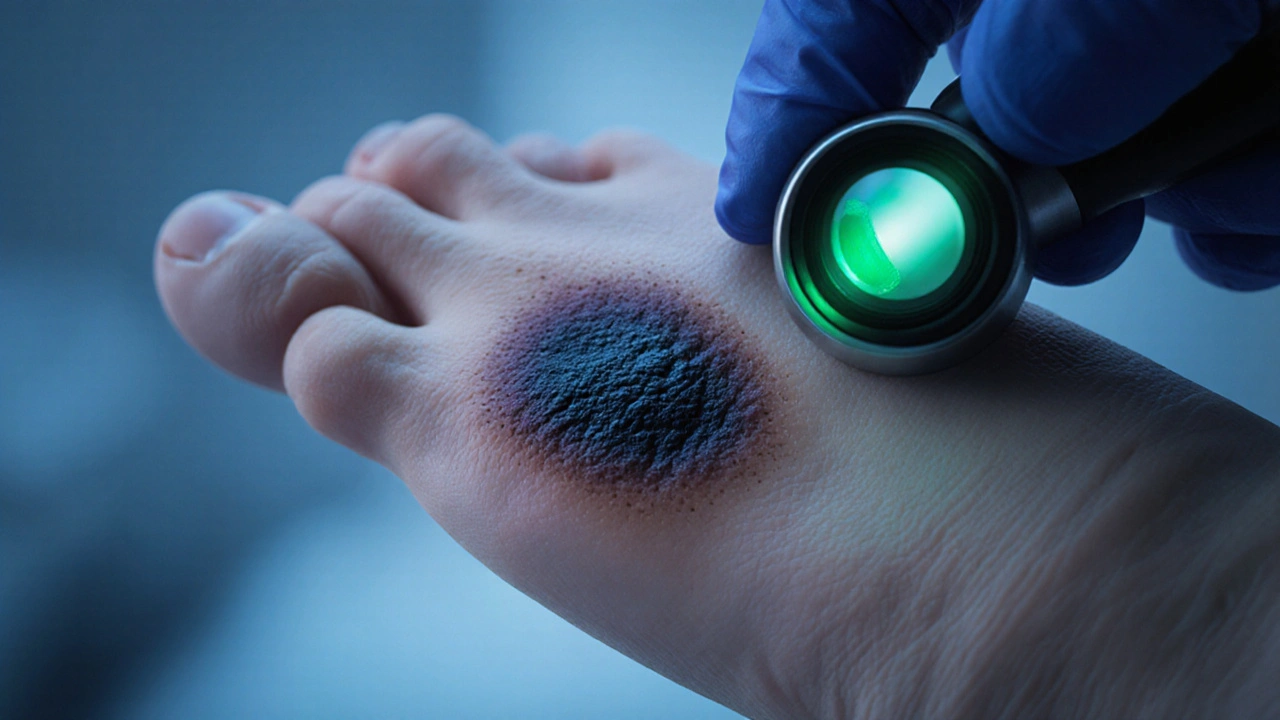Melanoma Risk Assessment Tool
Your Risk Factors
Check Your Skin
Your Risk Assessment
Melanoma is often seen as a disease that mainly affects fair‑skinned individuals, but the reality is far more complex. For people of color, the odds of spotting a dangerous spot early are lower, and the consequences can be more severe. This guide breaks down what you need to know - from risk factors and warning signs to prevention tips and treatment pathways - so you can stay ahead of the curve.
Understanding Melanoma
When it comes to skin health, melanoma is a type of skin cancer that originates in melanocytes, the cells that give skin its pigment. Unlike most skin cancers, melanoma can spread quickly to other organs if not caught early, making timely detection critical.
Melanoma accounts for roughly 1% of all skin cancers but causes the majority of skin‑cancer deaths worldwide. According to the World Health Organization, an estimated 324,000 new cases were diagnosed in 2023, highlighting its global impact.
Why People of Color Are Often Overlooked
People of color (POC) typically have darker skin tones classified as Fitzpatrick types IV-VI. These tones contain more melanin, which provides some natural protection against UV radiation. However, that protection is not absolute, and several systemic issues increase risk for POC:
- Healthcare providers may assume a lower risk and skip thorough skin exams.
- Public health campaigns often feature light‑skinned models, leaving POC without relatable visual cues.
- Melanoma in darker skin often appears on less‑sun‑exposed areas like the soles of the feet, palms, and under the nails, which many people don’t routinely check.
These gaps mean that melanomas in POC are frequently diagnosed at later stages, reducing survival rates.

Key Risk Factors
Even with increased melanin, several factors raise melanoma risk for POC:
- Family History: A first‑degree relative with melanoma triples the risk, regardless of skin color.
- Genetic Traits: Certain gene mutations (e.g., CDKN2A, MC1R) are linked to higher melanoma incidence across ethnicities.
- UV Exposure: Intermittent intense sunburns, especially during childhood, remain a major driver.
- Burns from Tanning Beds: Artificial UV sources bypass natural melanin protection.
- Immune Suppression: Organ transplant recipients or people on long‑term steroids have a heightened risk.
Understanding these factors helps you gauge personal risk and discuss screening with your clinician.
Spotting the Signs Early
Melanoma can look different on darker skin. The classic ABCDE rule (Asymmetry, Border, Color, Diameter, Evolving) still applies, but add the “U” for “Unusual” spots that appear on the palms, soles, or under the nails.
Key visual cues include:
- Dark brown to black lesions with irregular edges.
- Color variation ranging from tan to deep blue or even red and white patches.
- Lesions larger than 6mm (about the size of a pencil eraser).
- Changes in shape, size, or sensation over weeks or months.
- New dark streaks under the nail (known as a “longitudinal melanonychia”).
Perform a monthly self‑exam using a mirror for hard‑to‑see areas. If anything looks off, schedule a dermatoscopic exam dermatoscopy with a dermatologist.
Prevention Strategies That Work
Prevention isn’t just about sunscreen - it’s a whole‑body approach.
| Skin Type | Approx. Incidence per 100,000 | Common Sites |
|---|---|---|
| I‑II (Very Light) | 30‑40 | Face, arms, trunk |
| III‑IV (Medium) | 10‑15 | Back, legs, occasional face |
| V‑VI (Dark) | 2‑5 | Palms, soles, nail beds |
Even though incidence is lower in types V‑VI, the mortality gap makes prevention essential.
- Sunscreen: Choose broad‑spectrum SPF30 or higher. Apply 15minutes before sun exposure and reapply every two hours.
- Protective Clothing: Long‑sleeve shirts, wide‑brim hats, and UV‑blocking sunglasses reduce UV penetration.
- Avoid Peak Sun: Schedule outdoor activities before 10am or after 4pm when UV intensity drops.
- Regular Skin Checks: Pair self‑exams with annual professional skin exams, especially if you have risk factors.
For nail‑bed melanomas, avoid nail polish that can mask early changes and consider periodic nail‑bed photography.

Treatment Options and Outcomes
When melanoma is detected early (stage0‑I), surgical removal often cures the disease. Later stages may require a multimodal approach:
- Surgery: Wide local excision with margin control.
- Immunotherapy: Checkpoint inhibitors like pembrolizumab boost the body’s immune response.
- Targeted Therapy: BRAF‑mutated melanomas respond to drugs such as vemurafenib.
- Radiation: Used for in‑situ lesions near critical structures.
- Clinical Trials: Ongoing studies test novel combinations of immunotherapy and targeted agents, offering hope for advanced disease.
Survival rates improve dramatically with early detection: five‑year survival exceeds 95% for stageI, but drops below 30% for stageIV. This stark contrast underscores why prompt action matters.
Resources and Support
Being proactive is easier when you have the right tools:
- Clinical Guidelines: The American Academy of Dermatology (AAD) and NCCN publish skin‑cancer screening recommendations that include specific advice for POC.
- Patient Advocacy Groups: Organizations like the Melanoma Research Foundation and Skin of Color Society offer educational webinars and support networks.
- Mobile Apps: Apps such as MoleScope provide guided self‑exams and secure photo storage for dermatologist review.
- Community Clinics: Many city health departments run free skin‑cancer screening days targeting underserved neighborhoods.
Ask your healthcare provider about referrals to dermatologists experienced in skin‑of‑color diagnoses - their expertise can make a vital difference.
Frequently Asked Questions
Can people of color get sunburned?
Yes. While higher melanin provides some UV protection, intense or prolonged exposure can still cause sunburn, especially on areas with thinner skin like the scalp or hands.
Why do melanomas often appear on the soles or under the nails in darker skin?
Melanocytes are more abundant in acral (palmar, plantar, and sub‑ungual) regions. In darker skin, UV‑related lesions are less common, so acral sites become the primary locations where melanoma develops.
How often should I see a dermatologist for a full skin exam?
If you have risk factors (family history, genetic mutations, or prior skin cancer), an annual exam is advised. Without risk factors, a skin check every two years is generally sufficient.
Is sunscreen necessary if I rarely get sunburn?
Absolutely. UV radiation contributes to DNA damage even without visible burns. Daily broad‑spectrum sunscreen helps prevent both melanoma and premature aging.
What should I do if I notice a dark streak under my nail?
Schedule a dermatology appointment promptly. The clinician may perform a nail‑bed biopsy to rule out sub‑ungual melanoma, which requires early treatment.
Are there any new treatments on the horizon for advanced melanoma?
Research is exploring next‑generation checkpoint inhibitors, personalized neoantigen vaccines, and combination regimens that pair immunotherapy with targeted drugs. Clinical trials are recruiting worldwide, offering access to cutting‑edge options.
melanoma may be less common in people of color, but when it does occur, early awareness and routine skin checks can save lives. Take charge of your skin health today - the habit of looking closely and seeking professional advice can make all the difference.


Poorni Joth
We cant just ignore the fact that melanoama kills people, especially in communities that dont get the proper attention. It's a moral duty to push for better screenings, not just rely on the occasional doctor visit. If we stay silent, we become complicit in the suffering of our families. Every time we skip a self‑exam, we are betraying our own skin.
Better education, more outreach, and accountability are what we need right now.
Taryn Bader
Reading this made me feel so much hope. The advice is clear and easy to follow. I can actually start using sunscreen every day without feeling like I'm overreacting.
Myra Aguirre
It’s good to see actionable steps laid out. I’ll add monthly self‑exams to my routine and tell my friends to do the same.
Shawn Towner
Actually, the whole sunscreen hype is overblown. Lots of people use SPF 30 and still get skin damage because they stay in the sun for hours. Real protection comes from staying out of peak UV, not just slapping on a bottle.
Ujjwal prakash
While the article covers many essential points, it unfortunately glosses over the necessity of culturally competent dermatology, which is a critical gap; physicians often lack training in identifying acral melanomas, especially in Fitzpatrick V‑VI skin. Moreover, the statistics presented could benefit from a clearer breakdown by ethnicity, and the recommendations would be stronger with citations to recent peer‑reviewed studies, such as the 2022 JAMA Dermatology paper on melanoma outcomes in Black patients. Finally, the tool’s risk algorithm appears to assign a uniform weight to skin type, which may not reflect nuanced genetic risk factors; a more sophisticated model could improve predictive accuracy.
Diane Helene Lalande
Great post! Thank you for the thorough explanation and the practical checklist. It really makes the information feel doable.
Edwin Levita
Oh my god, this is exactly what we needed! The drama of missing a melanoma is real, but the calm steps you gave are a lifesaver.
Xander Laframboise
One thing that often gets missed is the role of vitamin D deficiency in skin health. Even though melanin blocks UV, low vitamin D can impair immune surveillance, potentially influencing melanoma risk. Regular blood tests can flag a deficiency early, and supplementing when needed is a simple preventive measure. Also, consider that certain chemopreventive agents, like nicotinamide, have shown promise in reducing non‑melanoma skin cancers and may have ancillary benefits for melanoma as well. Pairing these strategies with the standard sunscreen and exam routine creates a multi‑layered defense.
Jason Petersen
The data suggests early detection drastically improves survival rates; thus, routine screening should be standard practice for all skin tones.
Melissa Gerard
Sure, sunscreen is overrated 🙄
Cindy Knox
I love how you highlighted the hidden dangers on the soles and nails. Those spots are easy to miss, but your guide makes them impossible to ignore.
beverly judge
This guide is a solid resource for anyone wanting to stay proactive about skin health. I especially appreciate the list of community clinics and the suggestion to use apps like MoleScope for monitoring. If you’re looking for more support, the Skin of Color Society offers webinars that dive deeper into acral melanoma detection. Remember, sharing this information with friends and family can create a ripple effect of awareness.
Capt Jack Sparrow
Let me break this down for anyone still on the fence about how seriously we should take melanoma screening in people of color.
First, the mortality gap is stark: while incidence is lower, the five‑year survival for late‑stage disease plummets below 30 percent.
Second, the typical ABCDE rule doesn’t capture acral lesions, which are where most melanomas appear in darker skin.
Third, family history remains a powerful predictor regardless of skin tone, tripling risk when a first‑degree relative was affected.
Fourth, UV exposure still matters; intermittent intense sunburns in childhood elevate risk even if you have a higher melanin baseline.
Fifth, genetic mutations like CDKN2A and MC1R don’t discriminate by ethnicity; they increase susceptibility across the board.
Sixth, immune suppression-whether from transplant meds or chronic steroids-adds another layer of danger.
Seventh, regular professional skin exams catch these hidden lesions early; annual visits are a must for high‑risk individuals.
Eighth, self‑exams should focus on the palms, soles, and nail beds, not just sun‑exposed areas.
Ninth, broad‑spectrum SPF30+ protects against UVA and UVB, and it’s worth using even on cloudy days.
Tenth, protective clothing and avoiding peak sun hours are simple lifestyle tweaks that compound protection.
Eleventh, emerging therapies like checkpoint inhibitors have improved outcomes for advanced melanoma, but early detection is still the best weapon.
Twelfth, the community resources listed-like the Melanoma Research Foundation and local free‑screening events-are invaluable for underserved populations.
Thirteenth, technology aids us: apps for photo tracking and tele‑dermatology can bridge gaps where specialists are scarce.
Fourteenth, education matters; sharing these facts with family and friends can break the cycle of late detection.
Finally, taking ownership of your skin health today can literally save your life tomorrow.
Manju priya
Let’s take action now-schedule that skin exam, apply sunscreen daily, and encourage your loved ones to do the same. Together we can close the awareness gap! 😊
Jesse Groenendaal
It is absolutely unacceptable that a segment of the population receives subpar dermatological care. We must hold healthcare systems accountable and demand equitable screening protocols for all skin tones.
Persephone McNair
From a pathophysiological perspective, the melanocytic proliferation in acral sites involves distinct genetic signatures, such as KIT mutations, which differ from UV‑induced lesions. Incorporating molecular diagnostics could refine risk stratification for patients of color.
Murhari Patil
They don’t want you to know that the big pharma companies are pushing sunscreen as a cure‑all while ignoring the real culprits-environmental toxins and hidden UV‑emitting devices. Stay vigilant, question the narratives, and protect yourself with real science.
kevin joyce
Consider the epistemological implications of a health disparity that persists despite abundant knowledge. When we frame melanoma solely as a “fair‑skin issue,” we erode the ontology of patient experience for people of color. Bridging this gap requires a phenomenological approach: listening to lived narratives, integrating cultural competence into diagnostic heuristics, and redefining clinical epistemic standards.
michael henrique
Our nation's future depends on a healthy populace, and that includes protecting every citizen's skin, no matter their background. It's a patriotic duty to ensure that all Americans have access to top‑tier dermatology and the resources to prevent melanoma.